Before I get too rattled up on the JW Props again(LOL!) I do want to thank EVERYONE who has sent me emails, comments, and suggestions on how they feel about mine and their own feelings. As a very open and honest person I do not degrade anybody's opinion, I'm just very happy to hear other outlooks and understand other sides, there is very much going on! I respect those who have come forward on their views. Situations like this can be very touchy.
In this post I am not going to proceed to much more on other opinions and what else I have failed to mention. There is so much I have to say, and so much more others have had to say, it really is a big topic and concern in my opinion. This topic is so much more than "meets the eye".
(EDIT: Please excuse if there are misspellings, I currently cannot get my spell check to work, LOL!)
So, wool! Now, I don't have an SOP next to me currently to site anything(I would have loved to site more things in my last post) but will like to add this link here for an article on wool. It is nicely put together explaining the wool transition, and notes wool factors that apply to different varieties.
Jersey Woolies highest percentage for wool points fall under Texture. Texture is the feel to the coat on your hands and fingertips. Wool is to be coarse in texture. A way I explain this is "harsh to the hands". Faults can be on wirey textured coats(usually too coarse) and soft coats(lack of texture). A Jersey Wooly can be DQ'ed for too soft/cottony of a coat.

Here is a buck with very good texture and good guard hair. Guard hairs are what protect the underwool which can prevent webbing or matting. Good texture/guard hair can sometimes determine a correct JW coat, which should be easy and care free.

In most cases, with good texture takes away another property. Length or density. This animal has good length, and lacks in density.
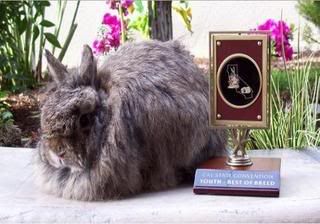
A chestnut doe who lacks in length but has good density, and good texture, which is common for this variety.
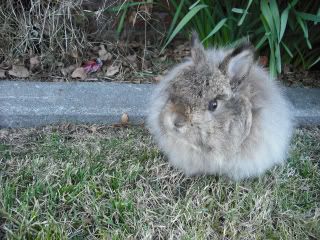
A chestnut newly turned senior buck with a soft coat. Appears "cottony" to the eye. Feels cottony too, has little or no texture at all. This is common for Junior coats on Juniors, however, if he molts and he still has a cottony coat, it is an extreme fault. Seniors with extremely cottony coats may be disqualified.
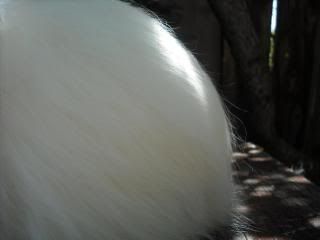
Silky texture is a fault. I've found animals with silky texture to have more "sheen" to the wool, which makes it look healthy and shiny. Texture is comparable to human hair.
Density takes second in the priority list. Density is the thickness of the coat, and should be evenly distributed in all areas. It should be thick and lush, "full of life" and not thin or open. Molts or transitioning coats can affect the density of a coat(downfall), and what I've found if grown in different seasons(for good or bad). Density is important, without the wool can be dull and drabby.
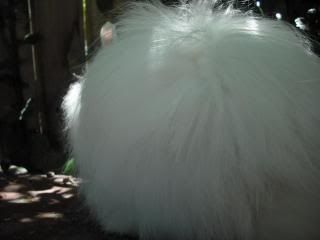
Here is a REW Buck with very good Density. He does have texture, and pretty good length overall for that combo.

It feels as plushy as it looks.

A Black Buck with lack of density. Very thin coat, short underwool. Does have decent texture and presense of guard hairs. In my opinion this is a poor JW coat. It lacks life, very boring.
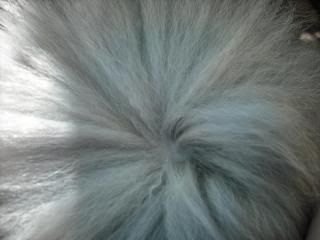
Crimp can sometimes play with density positively. I have had judges look for crimp in terms of judging for wool density.
Last but not least, Length. Length is the measurement of the wool from the hair shaft to the end of the hair. Though being least important, it is a wonderful thing to have. I am a sucker for long wool, specially does, I think it is very pretty. Too little wool can be disqualified. The longer the wool, the better. I do find longest wool does not have the best texture, and this is a very important role that length needs to protect the coat from webbing or matting. Though length is good, it is least important, and if it doesn't have the important bases(density or texture) it doesn't make it any better.
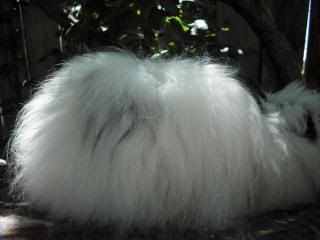
A doe who is currently pregnant so please excuse her pose. She has very good wool length. Good density, and decent texture, however I wish there were more distrubution of guard hairs to protect her undercoat from webbing. She requires a little more grooming than other woolies. (not bad though)
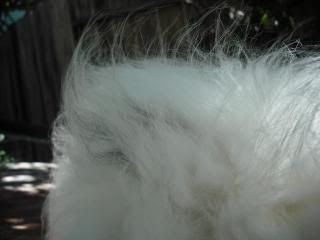
Presense of guard hair, but not quite enough with the amount of wool she has.
Transitioning coats can create all kinds of confusion. They can have good density on the sides but not over the top. Soft wool on the hips but coarse just above on the hindquarter. Juniors with junior coats can appear soft in texture but have grown their senior coat inbetween and have good texture. Molting rabbits can have long wool over the top and not over the sides. Points are deducted from coats like this for inconsisitancy and uneven-ness. Simply, it is not a over all finished coat for competition.

Blue doe who had an incomplete molt and soft wool is left over her flanks.
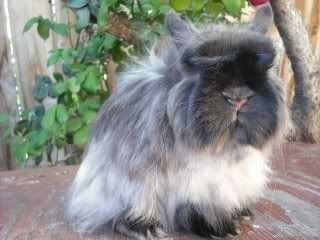
Sable doe with a chewn coat, showing the undertone of the Sable variety, which is slate, and in this photo appears greyish white.
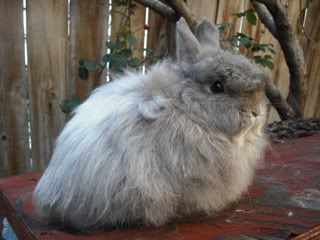
Opal Junior Buck transitioning out his junior coat, which is the cottony fluff over his midsection and hindquarters. You can see the coarser adult/senior coat in his front end.
Baby and Junior coats are two differnt stages for me. Baby coat is where I determine the future development of their senior coat, where it is even and easier to care for. Junior coat is the second stage that can start setting in as early as 12 weeks where it turns into soft cotten that can be easily pulled/plucked out when transitioning. Most breeders try to ignore the yucky fluff of the junior stage, and are rarely shown on the table due to immaturity, and sometimes judges lack of understanding this awkward stage. Not all baby coats turn out like their appearance in baby stages. When this happens, you understand you breeding line a little more.
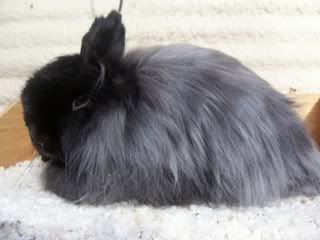
A black junior doe who is nothing more than soft wool. Though she does have a poor coat in this time, the judge gave her the benifit of doubt that show day and she won her first leg. A coat like this on a older senior should not be permissable.

A baby coat appears more silkier. It has texture, density, and length, all should be pretty even in this stage, and is something to keep in mind while waiting upon a senior coat, and when that is fully finished if it meets expectations.
As my post concludes, wool is very important based upon our breed. It's the icing to the cake. (and what is a cake without the icing? LOL) Some things stated above may just be my opinion, and may apply differntly to other breeders herds or opinions.
Take care!
Susie Cederlof
WWR


2 comments:
You definitely made someone that knows nut about JW understand fully what wool should be. The photos did great in proving the points.
Very informative post. Thanks for sharing Susie!
Great post Susie!! I learned a ton from this. It should be on the JW website IMO! :)
Post a Comment